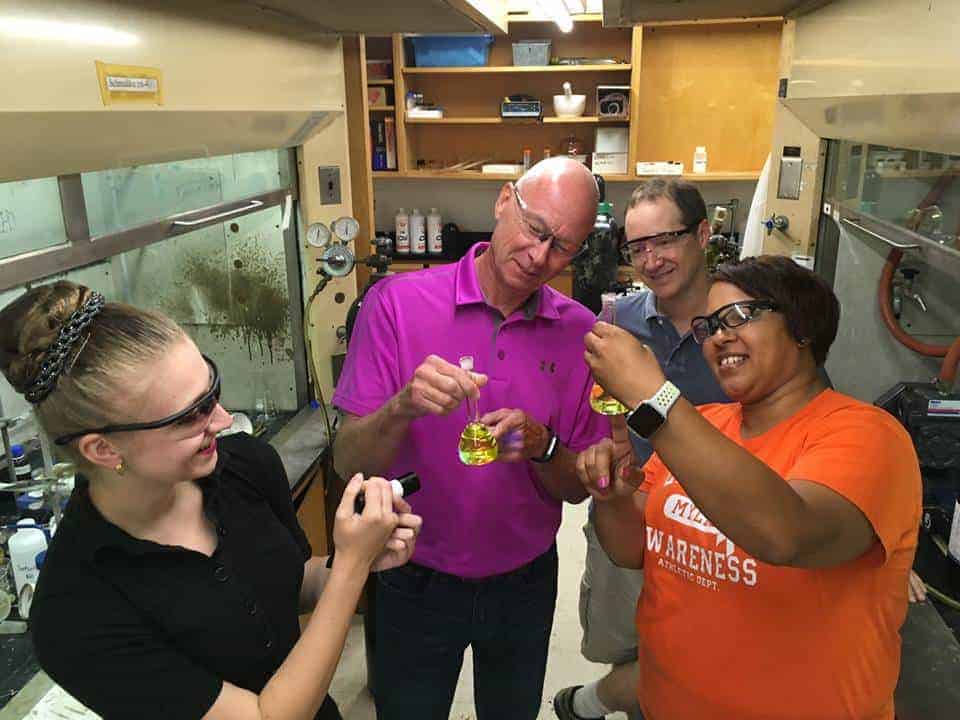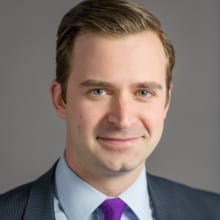The 13 teachers stand in a room with orange walls and tall, wooden lab tables. The classroom at Carmel Middle School in south Charlotte is windowless science room. Wires run from a battery to a small, handheld solar panel. A desk lamp with a naked bulb is bent over the panel.
Together, the teachers manipulate the light and watch its ability to charge the battery via the solar panel. They talk about how they will explain the concepts of energy to their students.
All of these educators are Charlotte-Mecklenburg Schools (CMS) teachers participating in the Charlotte Teachers Institute (CTI), a partnership between CMS, UNC-Charlotte, and Davidson College. The program serves 104 teachers annually. They receive stipends to participate in this seven-month fellowship to develop new curricula that they hope will inspire their students.
For two hours each month, they work with university professors—in this case science scholars—to create modules that align with CTI’s four pillars: content knowledge, creativity, leadership, and collaboration.
“They’re not taking something that is given to them,” says Scott Gartlan, the institute’s director. “They’re developing the curriculum themselves and then implementing it in their own classrooms.”
CTI started in 2009, modeled after similar programs elsewhere in the country. About three-quarters of the teachers who attend CTI come from high-need schools, and cohorts are divided evenly between elementary, middle, and high school educators. Often, former CTI fellows lead some of the 30 hours of instruction time.
Professional development is a line item on district budgets that feels the pressure caused by the elimination of state funding for continuing education, and the shakiness of federal Title II dollars. This leads North Carolina school districts to seek partnerships with outside organizations—or to develop their own plans for providing professional development for their teachers.
“School districts have money. You just have to be creative with how you use your money,” says Crystal Hill, assistant superintendent of curriculum and instruction for Cabarrus County Schools. Districts also need to be able to prove professional development is effective, she says, in order for school boards to continue to fund it.
The Charlotte Teachers Institute uses a shared funding model in which CMS and UNC Charlotte pay for the cost of the fellowship. Often, districts try to combine their dollars with private philanthropy and university system funds. Regardless, Gartlan says, each district needs to have a coherent strategy for providing high-quality professional development for its teachers and administrators. “Its important to have a philosophy of PD from the top down,” he says. “Ultimately it’s their employees, their students. So they have to be bought in.”
Success by Design
One of the ways districts have bought in is by creating categorized professional development to serve specific needs.
Charlotte-Mecklenburg Schools, for example, developed a professional development pathway for its “Success by Design” teacher-leader roles, which supports 29 participating schools, many of which serve at-risk student populations.
“Many of the courses we deemed critical for specific teacher-leader roles had a significant cost attached to them for materials and/or trainers,” says Melissa Stormont, the program’s manager. Stormont and others in the district applied for a Department of Public Instruction grant to help fund more job-embedded professional development for teacher-leaders—ongoing course training, coaching, and evaluation.
“Ongoing coaching is a critical component of professional development,” Stormont says. “Coaching is job-embedded and in-the-moment to develop specific skills. Teachers that are coached can apply learning immediately with more evidence of impact.”
Last year, schools that participate in Success by Design hired 94 teacher-leaders, including 49 multi-classroom leaders who support and coach an additional 251 teachers.
“Our approach,” Stormont says, “is thoughtful, sustainable, collaborative, research-based, flexible, and needs-based.”
State-funded programming
Although the General Assembly in 2011 eliminated more than $12 million in professional development support for school districts, the state does offer some continuing education programming.
Much of that happens at two campuses for the North Carolina Center for the Advancement of Teaching (NCCAT)—a stone building in Cullowhee and a white-sided structure on Ocracoke Island.
The NCCAT started in 1985 as a part of Western Carolina University but eventually became a standalone organization. During its week-long residencies, teachers huddle around tables with laptops and notes spread out, as they listen to seminars about everything from early grades literacy to ways to use coastal ecosystems in high school biology classes. “You have the opportunity to dive into a project, get to know your peers, and really work through an issue over a couple of days in a setting away from school,” says the center’s Todd Vinyard.
About 5,000 teachers from all of North Carolina’s 100 counties participate in NCCAT professional development programming in an average year. Lauren Genesky, a high school English teacher, sought out NCCAT seminars to focus on practices and outcomes that she could envision for her own classroom and students.
“It’s really important that teachers seek what they want to learn about,” she says. “Some teachers are frustrated when they are ‘volun-told’ to attend a particular session because of a county mandate.”
But NCCAT has felt funding squeezes in the past, too.
In 2014, then State Superintendent June Atkinson and State Board of Education Chairman Bill Cobey sent a letter to the General Assembly asking lawmakers to restore funding for NCCAT that had been removed post-recession. “NCCAT currently faces issues with funding sustainability and quite possibly closure,” they wrote, without state funding.
“When you come to one of these campuses, it gives you a chance to hear what teachers in other parts of the state are doing,” Vinyard says. “We feel it’s a valuable gift.
Connecting with colleagues
The importance of fellowship with other educators—be they from a district across the state or a school across town—is a common theme among professional development programs.
Each month, before they settle into the classroom for two hours of instruction, Charlotte Teachers Institute fellows sit down together for a casual meal. Scott Gartlan, the program’s director, says the dinners are often just as important as the classroom time.
“They’re coming from a variety of different schools, a variety of different subjects, and they get to break bread with their colleagues,” he says. “These community-building opportunities facilitate the development of a relationship.”
Relationships built through professional development programming, even between teachers from wildly different school environments, are powerful tools, Gartlan says. Those friendships often lead to coaching relationships, which enable regular feedback that teachers can immediately integrate into their practice.
The challenge, Gartlan says, is to do that well at scale. Larger districts have a tougher time offering high-quality professional development in a way that benefits big chunks of their teachers equally.
“Effective education, effective learning is very much a human enterprise that is based on interpersonal relationships over time,” Gartlan says. “To develop and reflect on that practice, it does need to be something sustained, where you’re building relationships over time and you’re not doing something off the cuff.”



